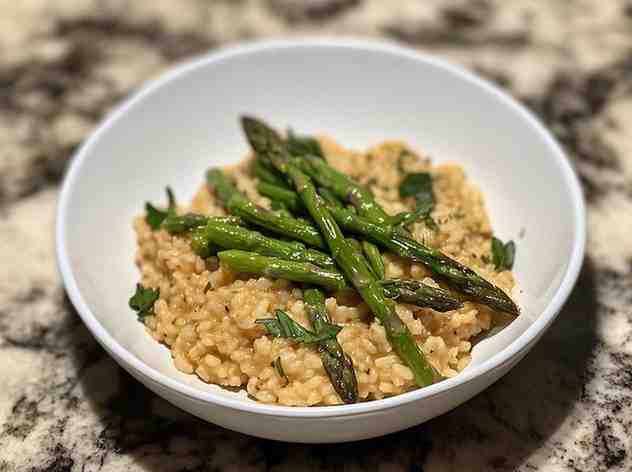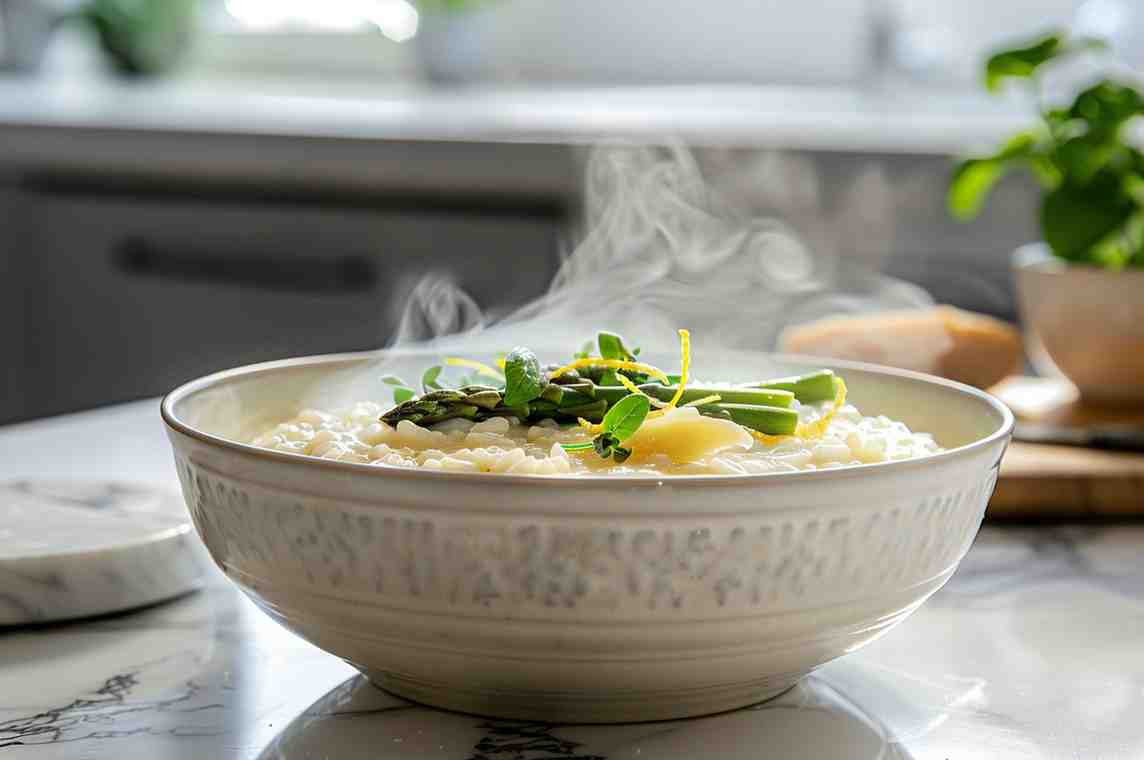Indulge in the creamy, comforting goodness of this asparagus risotto recipe. With the perfect balance of tender asparagus, aromatic garlic, and zesty lemon, this dish is sure to become a new favorite in your kitchen. The best part? It’s surprisingly easy to make and perfect for any occasion.
What You’ll Need to Make This Dish
The key to a fantastic asparagus risotto lies in the quality of the ingredients. Fresh asparagus is the star of the show, providing a delightful crunch and subtle sweetness. Arborio rice, a short-grain Italian rice, is essential for achieving that signature creamy texture. And, of course, a generous amount of Parmesan cheese adds a rich, savory flavor that ties everything together.
Ingredients List
- 1 pound fresh asparagus, trimmed and cut into 1-inch pieces
- 6 cups chicken or vegetable broth
- 2 tablespoons olive oil
- 1 onion, finely chopped
- 4 cloves garlic, minced
- 1 1/2 cups Arborio rice (short-grain Italian rice)
- 1/2 cup grated Parmesan cheese (aged varieties like Parmigiano-Reggiano or Grana Padano work best)
- 2 tablespoons unsalted butter
- 1 tablespoon fresh lemon juice
- 1 teaspoon grated lemon zest
- Salt and freshly ground black pepper, to taste
How to Make Asparagus Risotto Recipe
Prepare the Asparagus and Broth
Begin by preparing the asparagus. Trim off the tough, woody ends and cut the stalks into 1-inch pieces. Set aside. In a large saucepan, bring the chicken or vegetable broth to a simmer and keep it warm over low heat.
Cook the Risotto
In a large, heavy-bottomed pot or Dutch oven, heat the olive oil over medium heat. Add the chopped onion and sauté until translucent and tender, about 5 minutes. Add the minced garlic and cook for an additional minute, until fragrant.
Add the Arborio rice to the pot and stir to coat the grains with the oil and onion mixture. Toast the rice for 2-3 minutes, stirring constantly, until the edges of the grains become slightly translucent.
Then, begin adding the warm broth to the rice, one ladleful at a time. Stir the risotto frequently and allow each ladleful of broth to be almost fully absorbed before adding the next. Continue this process for about 20 minutes, or until the rice is tender and creamy.
Add the Asparagus and Finishing Touches
When the rice is almost done, add the asparagus pieces to the pot and stir to combine. Cook for an additional 5 minutes, or until the asparagus is tender but still slightly crisp.
Remove the pot from the heat and stir in the grated Parmesan cheese, butter, lemon juice, and lemon zest. Season with salt and freshly ground black pepper to taste. Serve the risotto immediately, garnished with extra Parmesan cheese and a sprinkle of fresh herbs, if desired.

Ingredient Swaps & Creative Variations
Protein Ideas
To add some protein to your asparagus risotto, consider stirring in some cooked, diced chicken or sautéed shrimp during the last few minutes of cooking. For a vegetarian option, try adding some crispy pan-fried tofu or a handful of cooked white beans to the finished dish.
Veggie Options
While asparagus is the star of this risotto, you can easily swap it out for other seasonal vegetables. Try using peas, mushrooms (like button or shiitake), or roasted cherry tomatoes for a delicious twist. You can also add some baby spinach or arugula to the risotto just before serving for a pop of color and extra nutrients.
Cream-Free or Dairy-Free Alternatives
If you’re looking to make a lighter version of this asparagus risotto, you can skip the butter and reduce the amount of Parmesan cheese. For a dairy-free option, simply omit the cheese and butter altogether and use a vegan Parmesan alternative or a sprinkle of nutritional yeast for a cheesy flavor. You can also replace the butter with a drizzle of high-quality extra virgin olive oil for added richness.
Pro Cooking Tips
| Tip | Why It Matters |
|---|---|
| Use warm broth | Adding warm broth to the risotto helps the rice cook evenly and absorb the liquid more efficiently. |
| Stir frequently | Stirring the risotto often helps release the starches from the rice, creating a creamy texture. |
| Toast the rice | Toasting the Arborio rice before adding the liquid helps develop a nutty flavor and prevents mushiness. |
| Add asparagus late | Adding the asparagus during the last few minutes ensures it stays bright green and slightly crisp. |
| Adjust consistency | If it’s too thick, add more broth. If too thin, simmer briefly to thicken. |
| Serve immediately | Risotto thickens as it cools. Serve right away for ideal texture and flavor. |
Nutritional Highlights
What’s Healthy About It
Asparagus is an excellent source of vitamins A, C, and K, as well as folate and fiber. It also contains antioxidants that may help protect against certain types of cancer and support overall health. The lemon juice and zest in this recipe provide a dose of vitamin C and can help boost iron absorption from the asparagus.
Dietary Considerations
This asparagus risotto recipe is naturally gluten-free, as it uses rice instead of wheat-based pasta or grains. However, it does contain dairy in the form of Parmesan cheese and butter. To make the dish vegetarian, simply use vegetable broth instead of chicken broth. For a vegan version, follow the dairy-free modifications mentioned in the “Cream-Free or Dairy-Free Alternatives” section.
Storage & Reheating
How to Store
If you have leftover asparagus risotto, let it cool to room temperature before transferring it to an airtight container. Store the risotto in the refrigerator for up to 3-4 days. Avoid freezing the risotto, as the texture may become grainy and the asparagus may become mushy upon thawing.
How to Reheat
To reheat your leftover asparagus risotto, place it in a microwave-safe bowl and add a splash of water or broth to help loosen the rice. Cover the bowl with a damp paper towel and microwave on high for 1-2 minutes, stirring halfway through, until heated through.
Alternatively, you can reheat the risotto on the stovetop. Place the risotto in a saucepan and add a small amount of water or broth. Heat the risotto over medium-low heat, stirring frequently, until it is warmed through and the liquid is absorbed. If the risotto becomes too thick, add more liquid as needed.
What to Know About Asparagus Risotto Recipe
Do you cook asparagus before adding to risotto?
It’s best to add the asparagus to the risotto during the last 5 minutes of cooking. This ensures that the asparagus retains its bright green color and slightly crisp texture. Cooking the asparagus for too long can cause it to become mushy and lose its vibrant color. By adding it near the end of the cooking process, you’ll achieve the perfect balance of tender rice and crisp-tender asparagus.
Can I use lemon instead of wine in risotto?
While white wine is a traditional ingredient in risotto, you can certainly use lemon juice as a substitute. The acidity of the lemon juice can help balance the richness of the dish and add a bright, zesty flavor. However, keep in mind that lemon juice will not provide the same depth of flavor as wine, so you may want to adjust the amount of lemon juice to taste. Start with a smaller amount and add more as needed to achieve your desired flavor profile.
What is Gordon Ramsay’s recipe for risotto?
Gordon Ramsay, the renowned British chef, has a classic recipe for mushroom risotto that showcases his signature cooking style. His recipe involves sautéing onions and garlic, toasting the Arborio rice, and gradually adding warm chicken stock to the rice while stirring constantly. He then adds sautéed mushrooms, Parmesan cheese, and butter to create a creamy, flavorful risotto. While his recipe doesn’t specifically include asparagus, you can easily adapt it by adding asparagus during the last few minutes of cooking, as described in this recipe.

